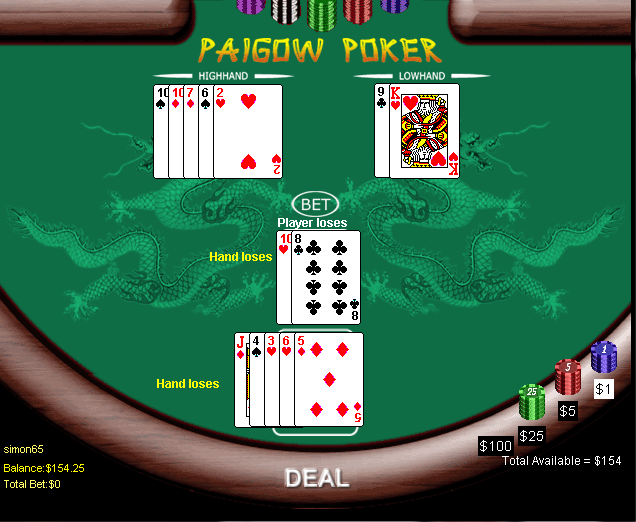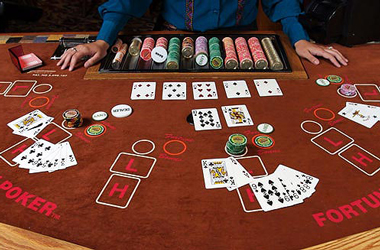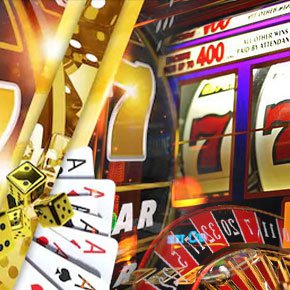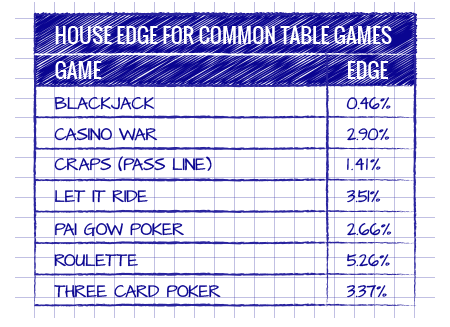Pai Gow Poker House Edge
Slot machines Pai Gow Poker Bonus House Edge are popular worldwide for their record-breaking jackpots and exciting themes. With few rules and strategies to consider, slot games are perfect for new casino players. Try some free slot games now or discover online slots to play for real money. In this video, the viewer will learn how to arrange their cards so they have the best house edge. This is also called the “House Way” and these are the rules. The house edge in Pai-Gow Poker depends on whether you’re banking or not. When you are banking and you play by the house way, you’re essentially playing with no house edge. However, when you’re not banking, the house edge is about 2.9%. If the house allows co-banking, then the house edge. The 5Dimes bonus casino offers Pai Gow in which a 2% commission goes to the player, rather than dealer, resulting in a house edge of 0.7%. Microgaming casinos offer an optional bonus bet with a 5.79% house edge. Other softwares that I am aware do not offer side bets. Variance and Bet Size.
On This Page
Introduction
EZ Pai Gow Poker is a commission-free pai gow poker variant. Instead of the usual 5% commission, if the dealer has exactly a queen high 5-card hand, then the hand will automatically resolve in a push. In addition, there are four side bets the player may wager on. There is also a fully-wild joker version is available to play in California.
Rules
The rules are the same as conventional pai gow poker, except:
- There is no commission.
- If the dealer has a queen-high hand, meaning the poker-value of the best five-card hand is exactly a queen high, the hand will automatically result in a push.
- Most casinos do not allow player banking. If they do, then the rules revert to normal pai gow poker for that hand.
- There are various side bets available, described separtely below.

Strategy
My strategy advice is that same as that for conventional pai gow poker. If you don't have time to study it, then if in doubt, ask the dealer to set your hand by the house way.
Analysis
The following table shows the probability and return from each outcome. The lower right cell shows a house edge of 2.47%.
EZ Pai Gow Poker Return Table — Partially Wild Joker
| Event | Pays | Probability | Return |
|---|---|---|---|
| Win | 1 | 0.274597 | 0.274597 |
| Push | 0 | 0.426112 | 0 |
| Lose | -1 | 0.299291 | -0.299291 |
| Total | 1 | -0.024694 |
Side Bets
There are lots of side bets that are available for casino management to tack onto EZ Pai Gow Poker. Here are some that I know of. You won't see all of these at any one table, probably just two or three of them.
Dynasty Bonus
Similar to the Fortune Bonus in conventional pai gow, the Dynasty Bonus pays if the player?s best five-card hand is at least a three of a kind. It does not matter how the player sets his hand. If another player gets a four of a kind or higher, the player will win an 'Envy Bonus.' The following table shows what each hand pays for both the player's hand and the Envy Bonus. The cell bottom row in the second to last column shows a house edge of 8.16%, before considering the Envy Bonus. The cell in the bottom row and last column shows that each additional player lower the house edge by 0.90%, because of the Envy Bonus.
Version 1
In this version the player has to bet only $1 to qualify for the Envy Bonus.
Dynasty Bonus Return Table — Version 1
| Event | Dynasty Pays | Envy Bonus | Combinations | Probability | Dynasty Return | Envy Bonus |
|---|---|---|---|---|---|---|
| A-5 Straight Flush + Natural AQ Suited | 2000 | $100 | 12 | 0.000000 | 0.000156 | 0.000008 |
| Natural 7-card Straight Flush | 2000 | $80 | 32 | 0.000000 | 0.000415 | 0.000017 |
| Wild 7-card Straight Flush | 1000 | $40 | 196 | 0.000001 | 0.001272 | 0.000051 |
| Royal Flush + Natural AQ Suited | 1000 | $60 | 72 | 0.000000 | 0.000467 | 0.000028 |
| Five Aces | 500 | $20 | 1128 | 0.000007 | 0.003659 | 0.000146 |
| Royal Flush | 120 | $10 | 26020 | 0.000169 | 0.020257 | 0.001688 |
| A-5 Straight Flush | 120 | $15 | 4308 | 0.000028 | 0.003354 | 0.000419 |
| Straight Flush | 50 | $4 | 180324 | 0.001170 | 0.058492 | 0.004679 |
| Four of a Kind | 25 | $1 | 307472 | 0.001995 | 0.049868 | 0.001995 |
| Full House | 5 | $0 | 4188528 | 0.027173 | 0.135865 | 0.000000 |
| Flush | 4 | $0 | 6172088 | 0.040041 | 0.160165 | 0.000000 |
| Three of a Kind | 3 | $0 | 7672500 | 0.049775 | 0.149326 | 0.000000 |
| Straight | 2 | $0 | 11034204 | 0.071584 | 0.143168 | 0.000000 |
| Losing combinations | -1 | $0 | 124556196 | 0.808056 | -0.808056 | 0.000000 |
| Total | 154143080 | 1.000000 | -0.081593 | 0.009031 |
The next table shows the overall house edge according to the number of players, including yourself, and various bet amounts. Note that the high edge is lowest at a bet of $1. This is because the win for the Envy Bonus is the same, regardless how much the player bets.
Dynasty Bonus House Edge — Version 1
| Players | $1 bet | $2 bet | $3 bet | $5 bet | $10 bet |
|---|---|---|---|---|---|
| 6 | 3.64% | 5.90% | 6.65% | 7.26% | 7.71% |
| 5 | 4.55% | 6.35% | 6.96% | 7.44% | 7.80% |
| 4 | 5.45% | 6.80% | 7.26% | 7.62% | 7.89% |
| 3 | 6.35% | 7.26% | 7.56% | 7.80% | 7.98% |
| 2 | 7.26% | 7.71% | 7.86% | 7.98% | 8.07% |
| 1 | 8.16% | 8.16% | 8.16% | 8.16% | 8.16% |
Version 2
In this version the player has to bet $5 to qualify for the Envy Bonus, which are usually five times as large as the Envy Bonuses in version 1.
Dynasty Bonus Return Table — Version 2
| Event | Dynasty Pays | Envy Bonus | Combinations | Probability | Dynasty Return | Envy Bonus |
|---|---|---|---|---|---|---|
| A-5 Straight Flush + Natural AQ Suited | 2000 | $500 | 12 | 0.000000 | 0.000156 | 0.000008 |
| Natural 7-card Straight Flush | 2000 | $400 | 32 | 0.000000 | 0.000415 | 0.000017 |
| Royal Flush + Natural AQ Suited | 1000 | $300 | 72 | 0.000000 | 0.000467 | 0.000028 |
| Wild 7-card Straight Flush | 1000 | $200 | 196 | 0.000001 | 0.001272 | 0.000051 |
| Five Aces | 500 | $100 | 1128 | 0.000007 | 0.003659 | 0.000146 |
| Royal Flush | 120 | $75 | 26020 | 0.000169 | 0.020257 | 0.002532 |
| A-5 Straight Flush | 120 | $50 | 4308 | 0.000028 | 0.003354 | 0.000279 |
| Straight Flush | 50 | $20 | 180324 | 0.001170 | 0.058492 | 0.004679 |
| Four of a Kind | 25 | $5 | 307472 | 0.001995 | 0.049868 | 0.001995 |
| Full House | 5 | $0 | 4188528 | 0.027173 | 0.135865 | 0.000000 |
| Flush | 4 | $0 | 6172088 | 0.040041 | 0.160165 | 0.000000 |
| Three of a Kind | 3 | $0 | 7672500 | 0.049775 | 0.149326 | 0.000000 |
| Straight | 2 | $0 | 11034204 | 0.071584 | 0.143168 | 0.000000 |
| Losing combinations | -1 | $0 | 124556196 | 0.808056 | -0.808056 | 0.000000 |
| Total | 154143080 | 1.000000 | -0.081593 | 0.009735 |
The next table shows the overall house edge according to the number of players, including yourself, and various bet amounts. Note that the high edge is lowest at a bet of $1. This is because the win for the Envy Bonus is the same, regardless how much the player bets.
Dynasty Bonus House Edge — Version 2
| Players | $5 bet | $10 bet | $15 bet | $20 bet | $25 bet |
|---|---|---|---|---|---|
| 6 | 3.64% | 5.90% | 6.65% | 7.03% | 7.26% |
| 5 | 4.55% | 6.35% | 6.96% | 7.26% | 7.44% |
| 4 | 5.45% | 6.80% | 7.26% | 7.48% | 7.62% |
| 3 | 6.35% | 7.26% | 7.56% | 7.71% | 7.80% |
| 2 | 7.26% | 7.71% | 7.86% | 7.93% | 7.98% |
| 1 | 8.16% | 8.16% | 8.16% | 8.16% | 8.16% |
Bonus Bet
This is very similar to the Dynasty Bonus, and is paired with games offering the G3 electronic side bet wagering. As far as I can tell at the Rampart casino, it is just titled the 'Bonus Bet.'
Bonus Bet Return Table
| Event | Dynasty Pays | Envy Bonus | Combinations | Probability | Dynasty Return | Envy Bonus |
|---|---|---|---|---|---|---|
| Natural 7-card Straight Flush | 8000 | $5000 | 32 | 0.000000 | 0.001661 | 0.000208 |
| Royal Flush + Natural AQ Suited | 2000 | $1000 | 72 | 0.000000 | 0.000934 | 0.000093 |
| Wild 7-card Straight Flush | 1000 | $500 | 196 | 0.000001 | 0.001272 | 0.000127 |
| Five Aces | 400 | $250 | 1128 | 0.000007 | 0.002927 | 0.000366 |
| Royal Flush | 150 | $50 | 26020 | 0.000169 | 0.025321 | 0.001688 |
| Straight Flush | 50 | $20 | 184644 | 0.001198 | 0.059894 | 0.004791 |
| Four of a Kind | 25 | $5 | 307472 | 0.001995 | 0.049868 | 0.001995 |
| Full House | 5 | $0 | 4188528 | 0.027173 | 0.135865 | 0.000000 |
| Flush | 4 | $0 | 6172088 | 0.040041 | 0.160165 | 0.000000 |
| Three of a Kind | 3 | $0 | 7672500 | 0.049775 | 0.149326 | 0.000000 |
| Straight | 2 | $0 | 11034204 | 0.071584 | 0.143168 | 0.000000 |
| Losing combinations | -1 | $0 | 124556196 | 0.808056 | -0.808056 | 0.000000 |
| Total: | 154143080 | 1.000000 | -0.077656 | 0.009268 |
Pai Gow Poker House Edge Definition
The next table shows the overall house edge according to the number of players, including yourself, and various bet amounts. Note that the high edge is lowest at a bet of $1. This is because the win for the Envy Bonus is the same, regardless how much the player bets.
Bonus Bet House Edge
| Players | $1-$4 bet | $5 bet | $10 bet | $15 bet | $25 bet |
|---|---|---|---|---|---|
| 6 | 7.77% | 3.13% | 5.45% | 6.22% | 6.84% |
| 5 | 7.77% | 4.06% | 5.91% | 6.53% | 7.02% |
| 4 | 7.77% | 4.99% | 6.38% | 6.84% | 7.21% |
| 3 | 7.77% | 5.91% | 6.84% | 7.15% | 7.39% |
| 2 | 7.77% | 6.84% | 7.30% | 7.46% | 7.58% |
| 1 | 7.77% | 7.77% | 7.77% | 7.77% | 7.77% |
Protection
Similar to Pai Gow Insurance, the Protection bet pays if the player?s best five-card hand is an ace high or less. The following table shows what each event pays, the probability, and contribution to the return. The lower right cell shows a house edge of 7.01%.
Protection Return Table
| Event | Pays | Combinations | Probability | Return |
|---|---|---|---|---|
| A-5 Straight flush | 120 | 4320 | 0.000028 | 0.003363 |
| 9 High Pai Gow | 100 | 31080 | 0.000202 | 0.020163 |
| T High Pai Gow | 25 | 248640 | 0.001613 | 0.040326 |
| J High Pai Gow | 15 | 963480 | 0.006251 | 0.093758 |
| Q High Pai Gow | 7 | 2719500 | 0.017643 | 0.123499 |
| K High Pai Gow | 5 | 6386940 | 0.041435 | 0.207176 |
| A High Pai Gow | 3 | 14430780 | 0.093619 | 0.280858 |
| Non-Pai Gow | -1 | 129358340 | 0.83921 | -0.83921 |
| Total: | 154143080 | 1 | -0.070066 |
Red/Black
The Red/Black wagers pay if the chosen color is in the majority of the player?s cards. In other words, the player needs at least four cards of the chosen side to win. The joker counts as neither color. The following table shows what each event pays, the probability, and contribution to the return. The lower right cell shows a house edge of 2.68%.
Protection Return Table
| Event | Pays | Combinations | Probability | Return |
|---|---|---|---|---|
| 7 | 5 | 657800 | 0.004267 | 0.021337 |
| 4 to 6 | 1 | 73033740 | 0.473805 | 0.473805 |
| 0 to 3 | -1 | 80451540 | 0.521928 | -0.521928 |
| Total | 154143080 | 1 | -0.026786 |
Queen's Dragon
The Queen's Dragon pays if the dealer has exactly a queen-high pai gow hand. Winning bets may pay 45 or 50 to 1, depending on how generous/stingy casino management is. The following two return tables show the house edge is 18.84% at 45 to 1, and 10.02% at 50 to 1.
Queen's Dragon — 45 to 1
| Event | Pays | Combinations | Probability | Return |
|---|---|---|---|---|
| Queen-high pai gow | 45 | 2,719,500 | 0.017643 | 0.793921 |
| Lose | -1 | 151,423,580 | 0.982357 | -0.982357 |
| Total | 154,143,080 | 1.000000 | -0.188436 |
Queen's Dragon — 50 to 1
| Event | Pays | Combinations | Probability | Return |
|---|---|---|---|---|
| Queen-high pai gow | 50 | 2,719,500 | 0.017643 | 0.882135 |
| Lose | -1 | 151,423,580 | 0.982357 | -0.982357 |
| Total | 154,143,080 | 1.000000 | -0.100222 |
Progressive Pai Gow
This is a progressive side bet found with G3 electronic betting units. The player may bet $1 to $25. All jackpot wins are the same, regardless of bet size, so I would never bet more than $1. As usual with progressive bets, wins are on a 'for one' basis. That means you don't get your original bet back, even if you win. To be consistent with other pages on this site, the following page is on a 'return basis,' meaning what the player can expect to get back for his bet, based on a $1 bet.
Progressive Pai Gow
| Event | Pays | Combinations | Probability | Return |
|---|---|---|---|---|
| 7-card Straight Flush | Jackpot | $228 | 0.000001 | 0.000000 |
| Five Aces | 0.1×Jackpot | $1,128 | 0.000007 | 0.000000 |
| Royal Flush | $500 | $26,092 | 0.000169 | 0.084636 |
| Straight Flush | $100 | $184,644 | 0.001198 | 0.119787 |
| Four of a Kind | $75 | $307,472 | 0.001995 | 0.149604 |
| Full House | $4 | $4,188,528 | 0.027173 | 0.108692 |
| All other | 0 | $149,434,988 | 0.969456 | 0.000000 |
| Total | 154,143,080 | 1.000000 | 0.462719 |
The bottom right corner shows a return of 46.27% on all fixed wins. The value of the progressive is 22.11% for each $100,000 in the meter. To reach 100% the meter would need to be $243,011.06. When I saw this bet at the Rampart casino on March 17, 2011, the meter was at $207,361, for a return of 92.12%. This was probably unusually high, because the Rampart has had a truck with a big sign in the back drive around Summerlin promoting the large jackpot.
Acknowledgement
I would like to thank game inventor Dan Lubin and mathematician Charles Mousseau of Future Sight Gaming for providing me the mathematical analysis report of this game, which this page is based on.
Written by:Michael Shackleford
In tiles, I've pretty much got simple strategy down, which makes the house edge when I play around 2.0%
In PGP, I'm much more skilled, and even know that keeping Full Houses together makes sense sometimes, even if other players yell at me. The Wizard writes that the house edge on PGP is right around 2.5% when using the house way. Do we have any idea how much optimal strategy reduces the house edge?
Administrator
In the worst case scenario analysis, you've got combin(53,7) player hands * 21 ways to split it * combin(46,7) dealer hands = 173,259,639,655,502,400 pairs of comparisons to make (pairs, because you need to compare the 5-card hands as well as the 2-card hands).
Now, in the same way that the number of starting hands in video poker can be reduced from 2,598,960 to 134,459 (for a 52-card deck), the number of starting hands for PGP can be reduced from 154,143,080 to 6,972,147. That brings our total down to 6972147 * 21 * 53524680 = 7,836,820,678,847,160 scenarios to test.
And while there are 21 ways to split a 7-card hand into a 5-card hand and a 2-card hand, not all of them are valid (some are foul). I come up with the following totals for the number of valid ways to split PGP hands:

| Valid Ways To Split | Total Hands | Unique Hands |
|---|---|---|
| 1 | 4,150,964 | 200,829 |
| 2 | 4,651,952 | 236,574 |
| 3 | 3,312,668 | 158,533 |
| 4 | 30,046,884 | 1,363,252 |
| 5 | 2,223,576 | 111,104 |
| 6 | 7,186,780 | 366,431 |
| 7 | 662,864 | 33,302 |
| 8 | 1,244,576 | 62,349 |
| 9 | 2,597,100 | 129,899 |
| 10 | 56,888,820 | 2,506,548 |
| 11 | 669,384 | 33,674 |
| 12 | 521,312 | 27,000 |
| 13 | 143,564 | 9,253 |
| 14 | 94,284 | 5,238 |
| 15 | 26,162,652 | 1,121,390 |
| 16 | 18,904 | 1,107 |
| 17 | 18,612 | 1,034 |
| 18 | 13,440,184 | 595,591 |
| 19 | 0 | 0 |
| 20 | 0 | 0 |
| 21 | 108,000 | 9,039 |
If you take the product of the leftmost and rightmost columns, and sum that product for each row, you come up with 64,977,799 unique hand/split scenarios that need to be tested against every possible dealer hand. This brings the total down to 64977799 * 53524680 = 3,477,915,898,579,320 player vs. dealer scenarios to test.
So in order to calculate the actual house edge, you need to be able to run through those 3.5 quadrillion scenarios before the power goes out... and you better hope that you didn't make a mistake in your house way code or in the handling of the Joker (or forget to make your program display the results when it's done processing 30 years later).
I think it would require a mainframe - or a freakin' cluster of them - to properly calculate this game in a reasonable amount of time without taking 'lossy' shortcuts.
 1. Most of the edge increase can come from properly playing two pair hands properly and very accurately (keeping 7's and 2's together with a KJ or KQ instead of requiring an ace, and keeping All two pairs together with an AK, etc.);
1. Most of the edge increase can come from properly playing two pair hands properly and very accurately (keeping 7's and 2's together with a KJ or KQ instead of requiring an ace, and keeping All two pairs together with an AK, etc.); Pai Gow Poker House Edge Casino Games
2. Some comes from properly handling straights and flushes with one pair (Play a pair of Jacks or better with and A-10 or better if the straight or flush has a queen or less top); straight or flushes with two pairs (Play the straight or flush if it has an AK top, or if the two pairs are 6's and 5's or less with a Q or less top); the hand 6543322 is better played as 32/65432 than as 65/33224 or 22/33654, Playing a high straight or flush with an AK top is always better than playing it as any two pairs, even a 'strong' two pair hand.
3. and a tiny amount of improvement comes from properly handling full houses with an AK top (don't split if the pair part are 4's or less) and properly handling four of a kinds, but they are so rare a misplay here means very little. Next to no improvement can come from worrying about how to handle full houses that also have a straight or flush with a pair (hands that always include the joker, and where either play is really never a misplay).
There is a slightly different strategy for banking, than for playing against a banker.
Also important to consider is to eliminate the wins and loses that cancel each other out. In this sense, it is better for the house or banker to win two hands and push four hands, than to win four hands and lose two back - for the same net two wins, especially on a commission-free version where no trivial income is made by 'churning hands.' In one case, two net wins comes from two transactions, where in the other, the two net wins comes from six transactions, four of which were useless.
Getting the extra 0.2% while using a strategy of one page, and is still easy to deal is the holy grail in PGP. For the house, the extra 0.2% can add up to about 2% extra in table hold.

Oops, doing the wrong kind of thinking, again. Sorry, Dan :)
